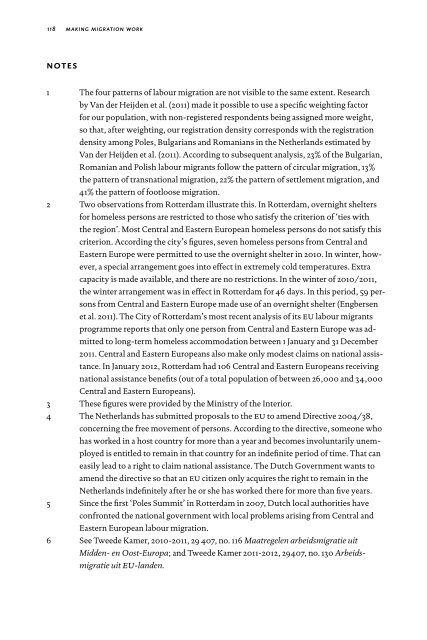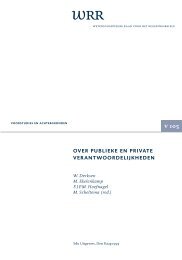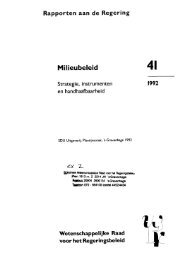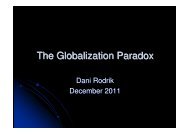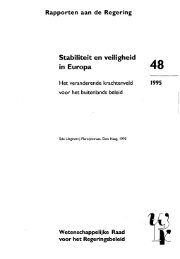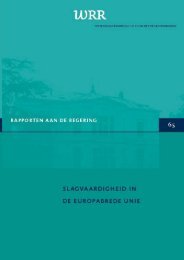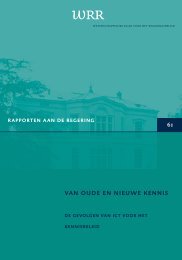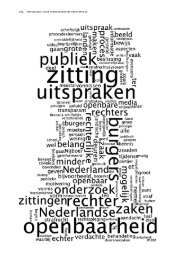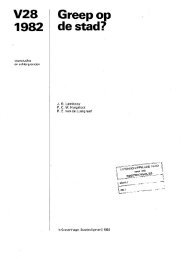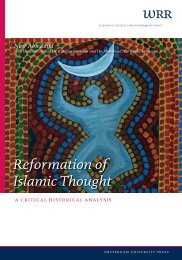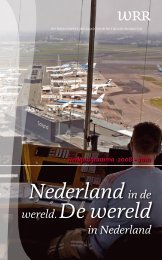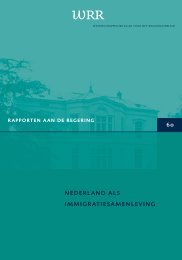Making Migration Work - Wetenschappelijke Raad voor het ...
Making Migration Work - Wetenschappelijke Raad voor het ...
Making Migration Work - Wetenschappelijke Raad voor het ...
- No tags were found...
You also want an ePaper? Increase the reach of your titles
YUMPU automatically turns print PDFs into web optimized ePapers that Google loves.
118making migration worknotes1 The four patterns of labour migration are not visible to the same extent. Researchby Van der Heijden et al. (2011) made it possible to use a specific weighting factorfor our population, with non-registered respondents being assigned more weight,so that, after weighting, our registration density corresponds with the registrationdensity among Poles, Bulgarians and Romanians in the Netherlands estimated byVan der Heijden et al. (2011). According to subsequent analysis, 23% of the Bulgarian,Romanian and Polish labour migrants follow the pattern of circular migration, 13%the pattern of transnational migration, 22% the pattern of settlement migration, and41% the pattern of footloose migration.2 Two observations from Rotterdam illustrate this. In Rotterdam, overnight sheltersfor homeless persons are restricted to those who satisfy the criterion of ‘ties withthe region’. Most Central and Eastern European homeless persons do not satisfy thiscriterion. According the city’s figures, seven homeless persons from Central andEastern Europe were permitted to use the overnight shelter in 2010. In winter, however,a special arrangement goes into effect in extremely cold temperatures. Extracapacity is made available, and there are no restrictions. In the winter of 2010/2011,the winter arrangement was in effect in Rotterdam for 46 days. In this period, 59 personsfrom Central and Eastern Europe made use of an overnight shelter (Engbersenet al. 2011). The City of Rotterdam’s most recent analysis of its eu labour migrantsprogramme reports that only one person from Central and Eastern Europe was admittedto long-term homeless accommodation between 1 January and 31 December2011. Central and Eastern Europeans also make only modest claims on national assistance.In January 2012, Rotterdam had 106 Central and Eastern Europeans receivingnational assistance benefits (out of a total population of between 26,000 and 34,000Central and Eastern Europeans).3 These figures were provided by the Ministry of the Interior.4 The Netherlands has submitted proposals to the eu to amend Directive 2004/38,concerning the free movement of persons. According to the directive, someone whohas worked in a host country for more than a year and becomes involuntarily unemployedis entitled to remain in that country for an indefinite period of time. That caneasily lead to a right to claim national assistance. The Dutch Government wants toamend the directive so that an eu citizen only acquires the right to remain in theNetherlands indefinitely after he or she has worked there for more than five years.5 Since the first ‘Poles Summit’ in Rotterdam in 2007, Dutch local authorities haveconfronted the national government with local problems arising from Central andEastern European labour migration.6 See Tweede Kamer, 2010-2011, 29 407, no. 116 Maatregelen arbeidsmigratie uitMidden- en Oost-Europa; and Tweede Kamer 2011-2012, 29407, no. 130 Arbeidsmigratieuit eu-landen.


